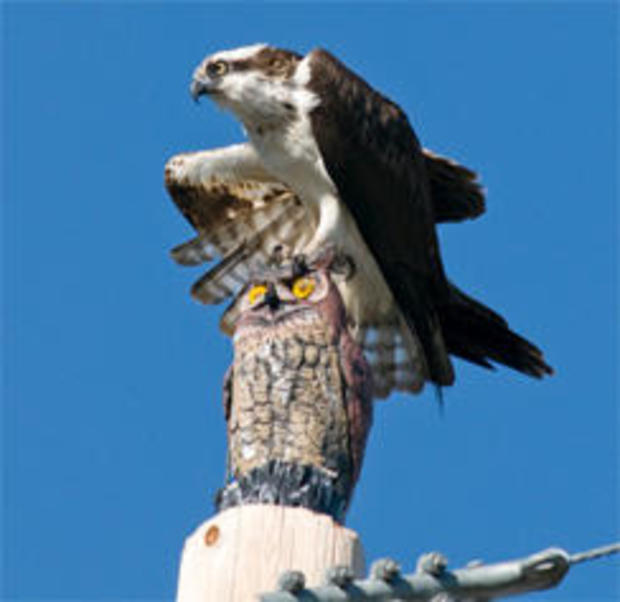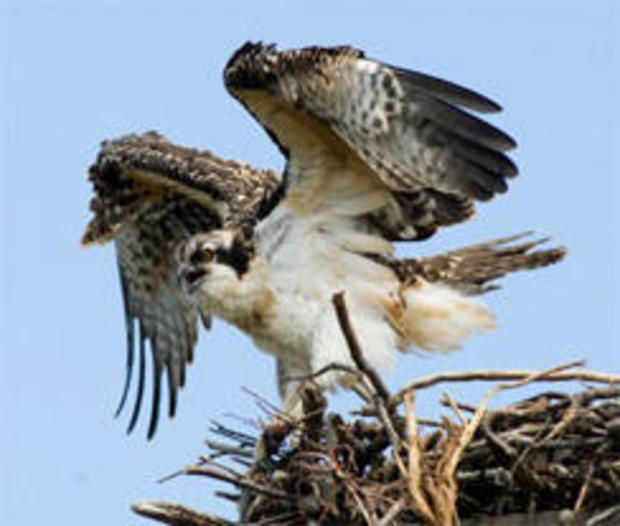Nature up close: Ospreys
By “Sunday Morning” contributing videographer Judy Lehmberg.
I spend a lot of my free time fly fishing. My favorite place to fish is the upper Missouri River near the small town of Craig, Montana. For most of its length the Missouri River is wide and muddy; however, the upper Missouri is clear and full of hungry rainbow, brown and cutthroat trout, so it is popular with fishers (both human and the winged variety).
There are a number of osprey nests along the river. My favorite is near a power pole. The electric company doesn’t want osprey electrocuting themselves, so they put up a life-sized plastic great horned owl on the pole, presumably to scare the osprey away. I often see an osprey sitting on the owl’s head looking around for fish as I float by. Somehow I don’t think the company’s idea is working.
Ospreys are one of the most widely-distributed raptors in the world; only peregrine falcons are found in more places. Ospreys live in North and South America, Europe, Asia, Indonesia, Africa, and Australia -- every continent except Antarctica. They are superbly adapted for catching the only food they eat: fish. One of their adaptations is their toes. When we pick up something with our hand we do it with several fingers on one side of the item and a thumb on the other side. When an osprey dives into the water to grab a fish, it does it with two talons on one side and two on the other. Fish are slippery, so their zygodactylous toes, with rough surfaces on the undersides, allow them to get a much firmer grip on their dinner. It hasn’t happened often, but occasionally I’ve caught a fish with puncture wounds -- two on one side of its body and two on the other. Those fish are the lucky ones that escaped from an osprey, and they escape from me, too, because I don’t keep them.
In the photo at left an osprey is carrying a not-so-lucky rainbow trout to its nest. The poor fish got caught by the osprey, but because the fish was so big the osprey dropped it. By chance the fish landed on a rocky island. The osprey then dove down to the fish and picked it up again.
You may notice how the osprey is carrying the fish. Osprey only weigh between two and four-and-a-half pounds. Some of the fish they catch (such as the one pictured) weigh as much as they do, so they have to carry them in an aerodynamically-sound way, with the least amount of wind resistance. When an osprey first catches a fish, it has it arranged much like you might hold a stick with both hands out in front of you, with the stick parallel to your body. Once the osprey becomes airborne the fish causes a lot of wind resistance so the osprey rearranges the fish so it is heading into the wind.
I’ve watched many osprey crash into the water to catch a fish. Sometimes they are successful; often they are not. But no matter their success, they have to get out of the water, and that is an amazing, seemingly gravity-defying act. When they come up for air after their dive, they look like a scraggly, drowned rat. They start flapping their wings and suddenly they are airborne. I’ve watched them do this hundreds of times, and I still don’t understand how they get out of the water. It is an amazing and awe-inspiring thing to watch.
Once they have gained about 10 or 15 feet, they sudden shake -- much like a dog would -- to get rid of some of the water. They always lose some altitude when they do that, so I guess that is why they wait until they get up a few feet before they do it.
If it is nesting season, a male osprey will invariably take his fresh catch to anywhere other than his nest and eat the head. If he lands close to the nest, the female calls for him to bring the fish to her. He finally does. She then starts very delicately tearing pieces off and giving them to the babies, occasionally swallowing a piece for herself.
They don’t have many predators, but they do have a constant irritation: bald eagles. Wherever there are osprey, usually bald eagles will be there, too. Bald eagles aren’t very picky about what they eat or where they get their next meal, and are constantly trying to steal an osprey’s catch. The more maneuverable osprey sometimes gets away, but if it sees the bald eagle gaining on him he will often drop his fish for the eagle, and leave to catch another.
Other threats to osprey occurred when DDT was being used. If DDT is in the water where the osprey fish, it will bioamplify, increase in concentration, as it is absorbed by plankton who are eaten by shrimp, or other small invertebrates, who are eaten by small fish, who are eaten by larger fish, etc. By the time an osprey eats a DDT-laden fish, the concentration is often high enough to interfere with egg production. The eggs from an osprey with enough DTT are so thin-shelled they crack much more easily than normal eggs, so the babies don’t survive. Since it is now illegal to use DDT, osprey have made an obvious comeback, and the IUCN Red List considers them a species of “least concern.”
When baby ospreys are about two months old, they are ready to leave the nest. They spend a lot of time flapping, testing and strengthening their wings. Ospreys can have anywhere between one and five babies. I’ve seen a nest were the parents successfully raised five young ones. Once they started flapping, the parents sometimes quit spending as much time at the nest -- it was just too crowded. They would occasionally come by and drop off a fish, which the babies proceeded to fight over. It was as if the parents said, “I’m tired of these babies and I’m not getting near them.”
Once the babies fledge they stay with their parents for a while, usually at least into the fall, and then they go their own way.
Judy Lehmberg is a former college biology teacher who now shoots nature videos.
For more info:
- Judy Lehmberg (Official site)
- Judy Lehmberg’s YouTube Channel
To watch extended “Sunday Morning” Nature videos click here!



